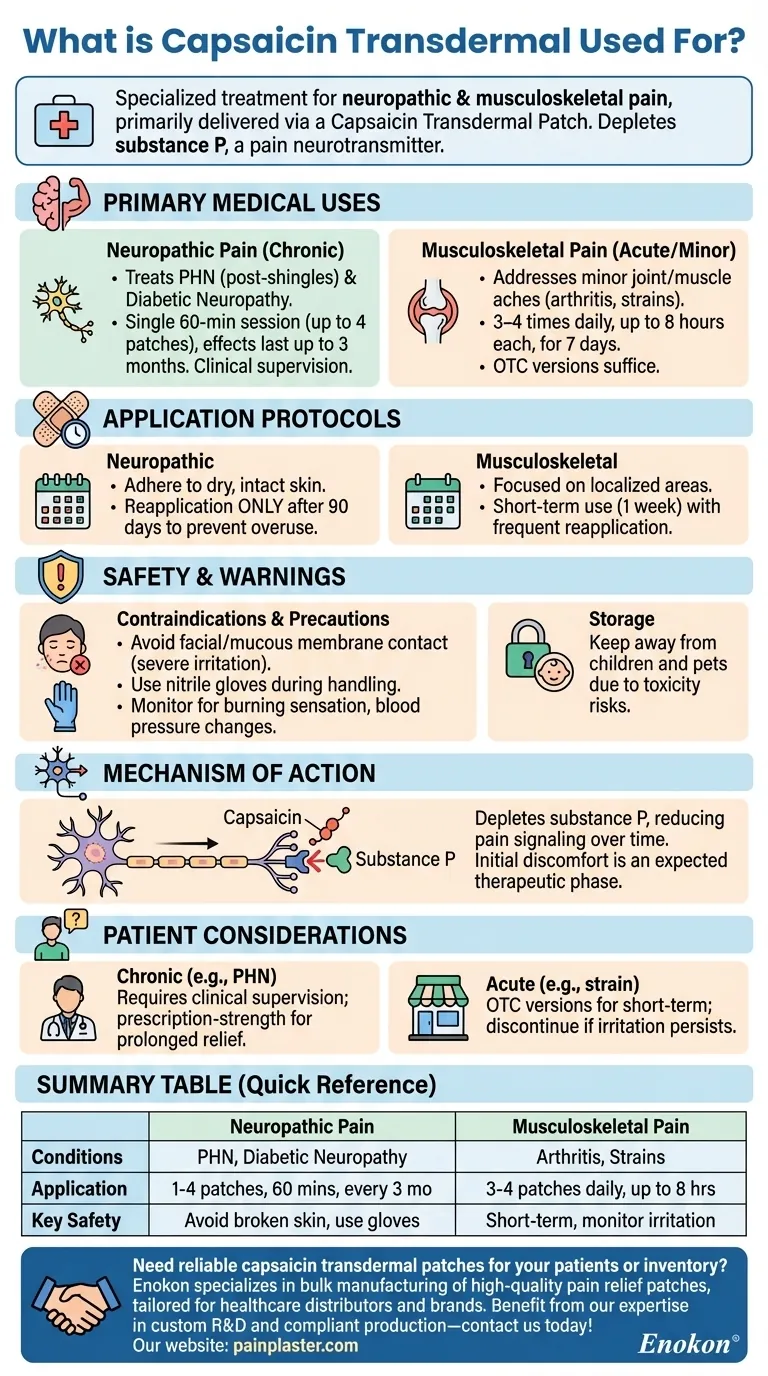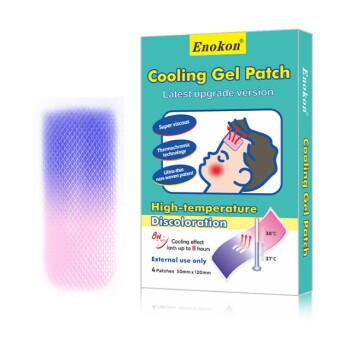Capsaicin transdermal, primarily delivered via a Capsaicin Transdermal Patch, is a specialized treatment for neuropathic and musculoskeletal pain. It targets conditions like postherpetic neuralgia (nerve pain following shingles) and diabetic peripheral neuropathy, as well as temporary relief for minor joint and muscle discomfort. Application protocols vary: a single 60-minute session (up to 4 patches) for nerve pain, repeatable every 3 months, versus daily applications for musculoskeletal issues. Safety precautions include avoiding sensitive areas, using protective gloves, and monitoring for localized reactions like burning or blood pressure changes.

Key Points Explained:
-
Primary Medical Uses
-
Neuropathic Pain Management:
- Treats postherpetic neuralgia (PHN) and diabetic peripheral neuropathy.
- A single application of up to 4 patches for 60 minutes, with effects lasting up to 3 months.
-
Musculoskeletal Pain Relief:
- Addresses minor joint/muscle aches (e.g., arthritis, strains).
- Applied 3–4 times daily for 7 days, with each patch worn up to 8 hours.
-
Neuropathic Pain Management:
-
Application Protocols
-
Neuropathic Pain:
- Patches adhere to dry, intact skin; avoid broken/irritated areas.
- Reapplication permitted only after 90 days to prevent overuse.
-
Musculoskeletal Pain:
- Focused on localized areas (e.g., knees, shoulders).
- Shorter-term use (1 week) with frequent reapplication.
-
Neuropathic Pain:
-
Safety and Warnings
-
Contraindications:
- Hypersensitivity to capsaicin or patch components.
- Avoid facial/mucous membrane contact (risk of severe irritation).
-
Precautions:
- Use nitrile gloves during handling to prevent accidental skin exposure.
- Monitor for transient side effects (burning sensation, elevated blood pressure).
- Storage: Keep away from children and pets due to toxicity risks if ingested.
-
Contraindications:
-
Mechanism of Action
- Capsaicin depletes substance P, a neurotransmitter involved in pain signaling, thereby reducing pain perception over time.
- Initial application may intensify discomfort before providing relief—a expected therapeutic phase.
-
Patient Considerations
-
For Chronic Conditions (e.g., PHN):
- Requires clinical supervision; prescription-strength patches offer prolonged relief.
-
For Acute Pain (e.g., muscle strain):
- OTC versions suffice for short-term use, but discontinuation is advised if irritation persists.
-
For Chronic Conditions (e.g., PHN):
By understanding these facets, healthcare purchasers can evaluate the patch’s suitability for inventory based on patient needs—whether for chronic neuropathic support or temporary musculoskeletal care. Always align procurement with evidence-based guidelines and safety profiles.
Summary Table:
| Aspect | Neuropathic Pain | Musculoskeletal Pain |
|---|---|---|
| Conditions Treated | Postherpetic neuralgia, diabetic neuropathy | Arthritis, strains, minor joint/muscle pain |
| Application | 1–4 patches for 60 mins (every 3 months) | 3–4 patches daily (up to 8 hours each) |
| Key Safety Notes | Avoid broken skin; use gloves | Short-term use; monitor for irritation |
| Mechanism | Depletes substance P for long-term relief | Temporary pain reduction |
Need reliable capsaicin transdermal patches for your patients or inventory?
Enokon specializes in bulk manufacturing of high-quality pain relief patches, tailored for healthcare distributors and brands. Benefit from our expertise in custom R&D and compliant production—contact us today to discuss your requirements!
Visual Guide

Related Products
- Capsaicin Chili Medicated Pain Relief Patches
- Heat Relief Capsicum Patch for Lower Back Pain Relief
- Far Infrared Deep Heat Relief Patches Medicated Pain Relief Patches
- Far Infrared Heat Pain Relief Patches Transdermal Patches
- Heating Pain Relief Patches for Menstrual Cramps
People Also Ask
- Can the pain relief patch be used with other external analgesic products? A Critical Safety Guide
- What side effects might occur from using capsaicin patches? Understand the difference between normal sensation and danger signs.
- How do you apply the Signal Relief patch to find the proper placement? A Step-by-Step Guide to Maximum Relief
- What is the purpose of capsaicin patches? A Guide to Temporary Pain Relief
- Can children use the pain relief patch? A Critical Safety Guide for Parents
















